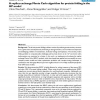294 search results - page 5 / 59 » Predicting the beta-helix fold from protein sequence data |
BIOCOMP
2006
13 years 9 months ago
2006
Most proteins function only when folded into a particular 3D configuration. Recently, a class of proteins has been discovered that do not fold into any particular configuration; t...
BMCBI
2002
13 years 7 months ago
2002
Background: An organism's ability to adapt to its particular environmental niche is of fundamental importance to its survival and proliferation. In the largest study of its k...
BIBM
2008
IEEE
14 years 2 months ago
2008
IEEE
Protein fold recognition is the prediction of protein’s tertiary structure (Fold) given the protein’s sequence without relying on sequence similarity. Using machine learning t...
BMCBI
2007
13 years 7 months ago
2007
Background: Solenoid repeat proteins of the Tetratrico Peptide Repeat (TPR) family are involved as scaffolds in a broad range of protein-protein interactions. Several resources ar...
BMCBI
2007
13 years 7 months ago
2007
Background: The ab initio protein folding problem consists of predicting protein tertiary structure from a given amino acid sequence by minimizing an energy function; it is one of...

